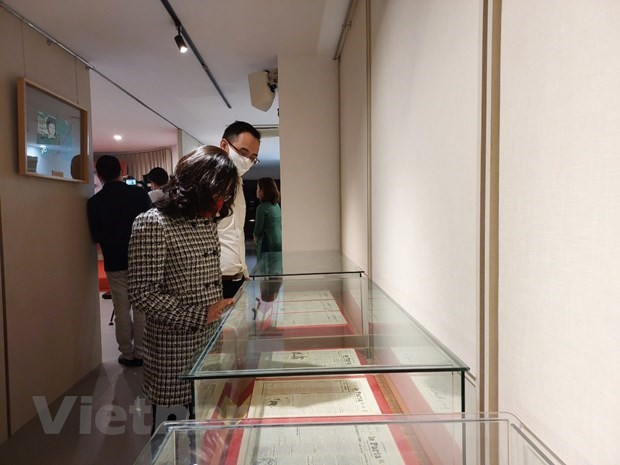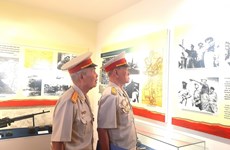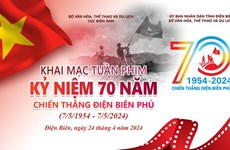Le Paria newspaper spreads Nguyen Ai Quoc’s revolutionary journalism
 Le Quoc Minh, Chairman of Vietnam Journalists Association, speaks at the seminar. (Photo: Vietnam+)
Le Quoc Minh, Chairman of Vietnam Journalists Association, speaks at the seminar. (Photo: Vietnam+)Hanoi (VNA) - On April 1, the Vietnam Press Museum held an exhibition and seminar to celebrate the 100th anniversary of Le Paria newspaper's first issue.
Some 100 years ago, the patriotic young man Nguyen Ai Quoc and international revolutionary activists from other French colonial countries such as Algeria, Tunisia and Morocco established the Colonial Union and published a newspaper in France called “Le Paria”.
Using the pen as a sharp combat weapon, journalist Nguyen Ai Quoc contributed to awakening the people of colonial countries to stand up to fight oppression and injustice and guide the way to liberation.
 Issues of Le Paria newspapers are on display at the Vietnam Press Museum. (Photo: Minh Thu/Vietnam+)
Issues of Le Paria newspapers are on display at the Vietnam Press Museum. (Photo: Minh Thu/Vietnam+)The newspapers were distributed in France. Some of them were distributed to Indochina and colonial countries via ocean-going ships.
In Le Paria, Nguyen Ai Quoc wrote many articles of different genres such as news, commentary, editorials, short stories, translations, skits, and caricatures. His articles not only exposed the brutal oppression and exploitation policy of the French colonialists towards the Vietnamese people and the people of Indochina, but also showed the cruel face of colonialism towards the people of other colonialist countries in the world.
As a newspaper published in France a century ago, it was under strict control of the French government at that time, so finding these documents was not easy, said Nguyen Van Ba from the Vietnam Press Museum who is in charge of the display.
 A caricature by Nguyen Ai Quoc (Photo: Minh Thu/Vietnam+)
A caricature by Nguyen Ai Quoc (Photo: Minh Thu/Vietnam+)Collector Than Quang Minh said: "There are not many domestic sources, so the museum has focused on exploiting overseas sources. The National Library of France offered up to 25 issues. However, they do not have the first publication, and our main goal is to find this first issue."
Following many letters sent to a number of archives centres in France, the US and the UK, results were found with the support of Fabienne Muddu from the French National Immigration History Museum. Than Quang Minh was known as Olivia Pelletier, an archivist on Indochina at the France had access to a repository of documents about Vietnam, including the National Overseas Archives. He first publication of Le Paria.
Thus, with the help of the National Library of France, the France National Overseas Archives and the Ho Chi Minh Museum, the Vietnam Press Museum has now collected more than 30 digital versions of Le Paria. The first issue was published on April 1, 1922, and the last issue was published on April 1, 1926.
At the seminar, Journalist Le Quoc Minh, Chairman of the Vietnam Journalists Association, affirmed that Le Paria newspaper represented the voice and forum of people in colonialist countries.
Journalist Nguyen Duc Loi, Standing Vice Chairman of the Vietnam Journalists Association shared,“Le Paria affirmed its principle and purpose right in the first issue with the mission of liberating people.”
The birth of Le Paria made an important contribution to the spread of Marxism-Leninism into Indochina and colonialist countries. The publication served to awaken the oppressed and exploited, and was an important milestone in the liberation movement in our country and the French colonies, Loi said.
 The exhibition lasts until May 19 at the Vietnam Press Museum. (Photo: Minh Thu/Vietnam+)
The exhibition lasts until May 19 at the Vietnam Press Museum. (Photo: Minh Thu/Vietnam+)Professor Ta Ngoc Tan, Standing Vice Chairman of the Party Central Committee Theoretical Council, said that Le Paria can be considered to be the first product of President Ho Chi Minh's journalistic career as a journalist. After Le Paria, President Ho Chi Minh founded a number of newspapers including Thanh Nien (1925), Kong Nong (1926), Duong Khach Manh (1927), and Bua Liem (1929).
Experts believe that this valuable document should be further researched and published to better clarify the development and history of the Vietnamese press. The publication also captures the thoughts of journalist-leader Nguyen Ai Quoc-Ho Chi Minh, those thoughts that gave birth to the nation and transformed the political frontier in the Indochine at that time./.












